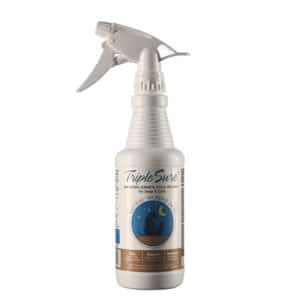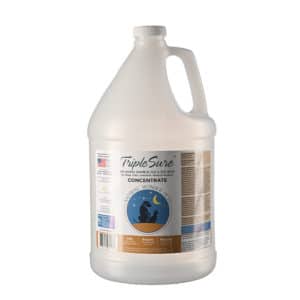Natural Flea Control
In the natural world, plants have evolved alongside all kinds of insects. Some insects are herbivores and like to eat plants. In order not to be eaten by these hungry insects, certain plants over time have developed a natural defense for survival.
Since plants can't run away, they use an organic chemical defense called an Octopamine Blocker. Insects rely on a neurotransmitter called Octopamine to regulate essential functions in the nervous system. Octopamine blockers found in some plants (such as Cedar trees and Peppermint plants) prevent insects from functioning normally, prevent reproduction, and cause certain death. This is natural flea control by Nature.

And since humans, animals, fish and birds don't even have Octopamine receptors, plants with Octopamine blockers are completely harmless. Pesky insects including fleas, ticks, mosquitoes, flies, bed bugs, mites, and lice are deterred and killed naturally using these well-known plants. This explains why natural flea control using nature’s own formula is effective yet safe.
TripleSure® Natural Flea & Tick Spray for Dogs and Cats relies solely on plant based Octopamine blockers to kill and deter insects but keep humans and animals safe. Veterinarian approved for year-round use. 90-day money-back guarantee.
*FDA disclaimer: The statements made about specific herbs or products on this website have not been evaluated by the United States Food and Drug Administration (FDA) and are not intended to diagnose, treat, cure or prevent disease. All information provided on this website or any information contained on or in any product label or packaging is for informational purposes only and is not intended as a substitute for advice from your veterinarian or other health care professional. You should not use the information on this web site for diagnosis or treatment of any health problem. Always consult with a healthcare professional before starting your dog or cat on any new vitamins, supplements, diet, or exercise program, before giving any medication, or if your pet has or you suspect it might have a health problem.
Fleas, Ticks, and Other Pests
Fleas, ticks, and other pests are a serious problem for pets and pet owners. These pests are not only painful and annoying but they carry harmful microorganisms. As our pets have increasingly moved into our homes it has become even more important to make sure that the pests don't move inside with them. This has led to a range of products to prevent pest infestation.
Conventional Medications for Flea Control
Conventional medications for flea control rely upon poison to kill the bugs and prevent re-infestation. Most popular flea sprays are made up of synthetic chemicals that slowly poison your pet in order to poison the insects.
Using such medications carries considerable risk. Some animals may have very bad reactions from even small doses. Side effects that might be expected range from loss of appetite, vomiting, and diarrhea, to behavior changes like aggression or anxiety, and serious long-term problems like fibroid cancer, liver toxicity, brain lesions, and other issues.
Vicious Cycle
Flea infestation leads to other serious problems for your pet, including worms. Worm eggs are ingested by fleas, then the fleas get on your pet. When your pet bites the fleas to get them off, she ingests the flea and the worm egg, leading to your pet becoming infested with worms. For this reason, in order to prevent internal parasites in your pet, it is essential also to control external parasites like fleas.
If you have fleas, there's a good chance that your pet is also suffering from internal parasites. To take care of all the pests and parasites, approach the problem on two levels. FourGuard Herbal Parasite Formula for Dogs & Cats attacks worms internally while TripleSure safeguards against external pests.
We've Harnessed Plant Power to Kill Fleas
Natural Flea Control is not Rocket Science. It’s simply a natural organic chemical defense produced by plants to avoid being eaten alive by insects.
Natural Flea Control
- TripleSure® is a 100% safe and natural flea control that relies on naturally occurring plant compounds that are harmless to people and pets
- Does NOT work by poisoning your pet, as many popular brands do
- Cedarwood oil and peppermint oil work together to safely kill and deter insects
- Oil-in-water solution that you can spray directly on your pet and on bedding and places insects are likely to hide
Benefits of Natural Flea & Tick Control
- Kills fleas, ticks, and bedbugs on contact on your pet, on bedding, or on anything else in your home
- Repels Fleas, Ticks, Mosquitoes, Flies and Bees
- Both active ingredients, Cedar Oil and Peppermint Oil, verified “minimum risk” by the United States Environmental Protection Agency
- Natural flea control with only two active ingredients so as not to overwhelm your dog or cat’s hyper sense of smell
- Avoid the risks associated with conventional flea medications which work by poisoning your pet in small doses
Natural Ingredients
Cedarwood oil has been used throughout the ages to ward off and kill insects that have plagued us, our livestock, and our pets. King Solomon's tomb was made from the Cedars of Lebanon, making it impervious to attack from insects. Ancient Egyptians soaked papaya leaves in cedar oil to mummify their dead.
The pioneering forefathers of America used cedarwood chips on the floor of their cabin to ward off insects. Today the tradition of using cedarwood to resist insects is continued with cedar clothes hangers, cedar chests, and pillows stuffed with cedar wood chips as bedding for dogs and cats.
Peppermint oil is effective not just for culinary uses, stomach soothing qualities, and aromatic odor. Peppermint oil also contains one of the most lethal octopamine blockers in all of nature. Peppermint oil has the power to kill insects on contact and prevent re-infestation.
Cedarwood oil and peppermint oil, combined with ethyl lactate (a natural emulsifier) and filtered water, create a natural flea control spray that keeps you and your pet free from pesky insects.
Application Instructions
Every two weeks, depending on your pet’s outdoor activities, spray liberally but not to the point of saturation. Begin spraying your pet at the tail and continue with the entire coat, including legs and under body. Then pamper your pet by hand fluffing the fur in the opposite direction it normally lies to assure penetration to the skin.
TripleSure® may also be used around the house where flea infestations and ticks hide. Spray liberally on your pet’s bedding and play areas, including door and window thresholds, corners, cracks, and crevices. Veterinarian approved for year-round use.
TripleSure® natural flea control and tick killer is an oil-in-water solution that you spray on your pet and around the house. TripleSure® is a healthy, convenient, premium product made with the same high standards as those applied to products made for human use.



